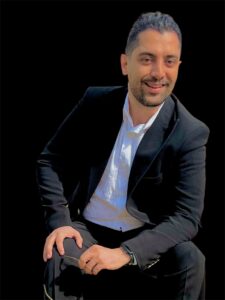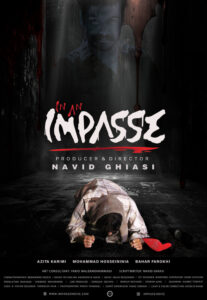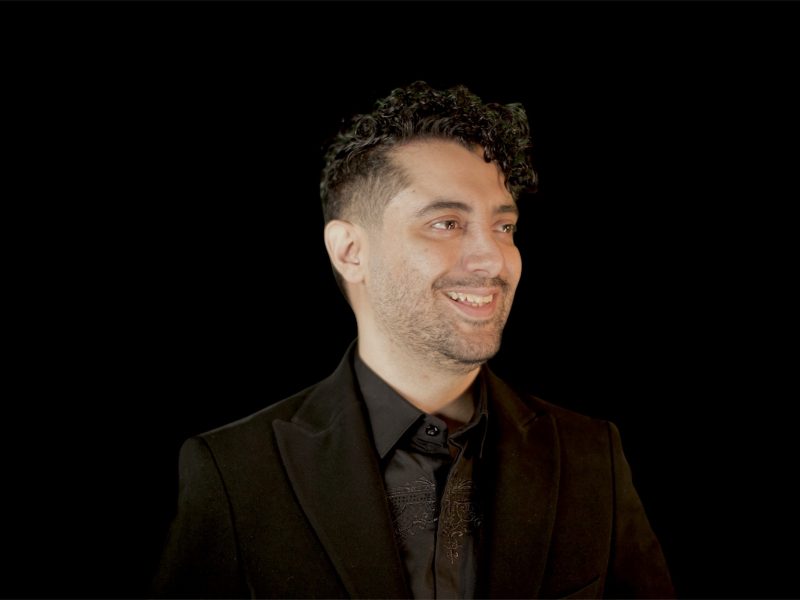In “In an Impasse,” I was most eager to explore themes of moral conflict, survival, and the emotional pressures faced by ordinary people in extreme situations. I wanted the audience to feel Sara’s journey as real and relatable.: Navid Ghiasi
What inspired you to pursue a career in filmmaking, and how did your early experiences in Tehran shape your artistic vision?
My inspiration to pursue filmmaking came from a deep desire to tell human stories that reflect real emotions and social realities. Growing up in Tehran, I was constantly exposed to a variety of personal and social struggles, which made me acutely aware of the complexities of human behavior and relationships.
These early experiences shaped my artistic vision by teaching me to observe life closely, embrace authenticity, and focus on nuanced emotional storytelling. I learned that even small, everyday moments could carry profound meaning and that cinema could be a powerful medium to explore both personal and societal issues.
Can you share a pivotal moment during your studies at Film School that significantly influenced your approach to storytelling?
A pivotal moment during my studies at film school was when I realized that storytelling is not just about events, but about the emotional and moral journey of the characters. One particular workshop challenged us to focus on the inner conflicts and psychological layers of a character, rather than just external plot points.
This lesson greatly influenced my approach to storytelling. For example, in “In an Impasse,” Sara’s choices are deeply shaped by her moral dilemmas and personal pressures, especially her devotion to her mother, which she prioritizes over conventional ethics. I learned that the depth of character and emotional truth is what truly engages audiences.
In your debut short film, “In an Impasse,” what themes were you most eager to explore, and how did you convey them visually?
In “In an Impasse,” I was most eager to explore themes of moral conflict, survival, and the emotional pressures faced by ordinary people in extreme situations. I wanted the audience to feel Sara’s journey as real and relatable.
To convey this visually, I focused on a naturalistic style, using real locations, natural lighting, and authentic performances. Every choice—lighting, framing, and sound—was intended to reflect her psychological and emotional state while keeping the experience grounded in realism. The goal was for the audience to feel immersed in her world and emotionally connected to her struggles.
How do you balance your roles as a director, writer, and producer when working on a project? Do you find one role more fulfilling than the others?
I personally enjoy directing the most, as it allows me to bring the story and characters to life exactly as I envision them. However, because I did not have a sponsor or significant funding, and the production costs were very high, I had to take on multiple roles—director, writer, and producer—to make the film happen.
Many of the ideas I wanted to implement could not be realized due to budget constraints. Perhaps if we had more resources, the film could have been even more engaging and visually striking. Despite these limitations, I managed to complete the film with creativity and determination, making the best possible work under the circumstances.

What are you currently working on?
Currently, I am working on my next film project, “War.” This film represents a significant step forward in my filmmaking journey. Compared to my previous work, it is much stronger, more cohesive, and carefully structured, with a story and characters designed to engage and surprise the audience.
“War” is an opportunity to explore deeper emotional and social themes, refine my storytelling, and deliver a cinematic experience that is both compelling and memorable. I am confident that it will resonate with viewers and demonstrate my growth as a filmmaker.
How do you approach character development in your films, and what techniques do you use to make them relatable to audiences?
When developing characters, I focus on their inner world, motivations, and personal struggles. I try to understand what drives them, what fears or desires shape their decisions, and how they respond to extreme situations.
To make characters relatable, I emphasize authenticity and realism. I rely on naturalistic dialogue, genuine performances from actors, and situations that reflect real-life challenges. By showing both strengths and vulnerabilities, the audience can connect emotionally and understand their choices on a deeper level.
As a filmmaker emerging from Iran’s vibrant cinema scene, what unique challenges and opportunities do you face in the international film landscape?
 Coming from Iran’s cinema scene offers both unique challenges and opportunities. One challenge is navigating cultural and political limitations that can affect what stories we can tell and how they are received internationally. Access to funding and resources can also be limited, which requires creativity and resourcefulness.
Coming from Iran’s cinema scene offers both unique challenges and opportunities. One challenge is navigating cultural and political limitations that can affect what stories we can tell and how they are received internationally. Access to funding and resources can also be limited, which requires creativity and resourcefulness.
At the same time, Iranian cinema is recognized worldwide for its emotional depth, realism, and storytelling strength. This opens opportunities for international festivals, collaborations, and audiences who are curious about authentic, human-centered narratives. I see these challenges as a way to push my creativity and tell stories that resonate universally.
What role do you believe music plays in enhancing the narrative of a film, especially considering your background as a singer and songwriter?
Music is a powerful storytelling tool that can shape the emotional tone, highlight character emotions, and deepen the audience’s connection to the story. My background as a singer and songwriter allows me to think about rhythm, mood, and lyrical expression when creating or selecting music for a film.
In my work, music is not just an accompaniment—it is an integral part of the narrative. It can amplify tension, underscore emotional shifts, and sometimes even tell what words cannot. By integrating music thoughtfully, I aim to create a more immersive and emotionally resonant experience for the audience.
Winning the Best Actress Award at the Stockholm City Film Festival must have been a significant milestone. How did that recognition impact your career and future projects?
Winning the Best Actress Award was indeed a significant milestone, not just for the recognition itself, but for the validation it provided to the entire team and the story we wanted to tell. It reinforced my belief in pursuing authentic and emotionally driven storytelling.
I have to say, I feel even happier when a member of my team wins an award than when I receive one myself. Their success is a reflection of the collaboration, dedication, and talent that made the project possible.
This recognition also opened doors for international collaborations, festival invitations, and increased visibility for my work. It gave me the confidence to take bigger creative risks in my future projects, knowing that audiences and professionals appreciate sincerity and depth in cinema.

What do you think sets your work apart from other contemporary filmmakers, and how do you hope to influence the next generation of artists?
I believe what sets my work apart is my focus on deep emotional authenticity and realistic storytelling, even when resources are limited. I aim to explore moral dilemmas, personal struggles, and social issues in a way that is relatable and thought-provoking for audiences.
Through my films, I hope to inspire the next generation of filmmakers to value honesty, emotional depth, and creativity, rather than relying solely on spectacle or large budgets. I want young artists to see that with passion, persistence, and careful observation of human nature, it is possible to create stories that resonate across cultures and leave a lasting impact.
What stories or themes are you passionate about exploring in your future projects, and why do they resonate with you?
In my future projects, I am passionate about exploring human resilience, moral dilemmas, and the complexity of social relationships. I am drawn to stories that reveal the emotional depth of ordinary people facing extraordinary circumstances.
These themes resonate with me because I believe cinema has the power to reflect society, evoke empathy, and provoke thought. I want to create films that not only entertain but also connect audiences to the struggles, choices, and emotions of real people, inspiring reflection and discussion.
Are there any filmmakers or artists who inspire you, and how have they influenced your work?
Yes, I am inspired by filmmakers who combine realism with emotional depth and tell stories that focus on human experiences. Directors like Asghar Farhadi, Abbas Kiarostami, Saeed Roustayi, Masoud Kimiayi, and some international auteurs have influenced me in how they capture subtle human emotions and moral complexities.
Their work has taught me to pay attention to character-driven narratives, authentic performances, and the power of simple yet profound storytelling. I strive to bring a similar honesty and emotional resonance to my own films, while also exploring my unique voice and perspective.
In your opinion, how can cinema serve as a tool for social change, and what responsibility do filmmakers have in addressing societal issues?
 I believe cinema has the power to reflect society, raise awareness, and spark meaningful conversations. Through storytelling, films can highlight social injustices, moral dilemmas, and human struggles, helping audiences see the world from different perspectives.
I believe cinema has the power to reflect society, raise awareness, and spark meaningful conversations. Through storytelling, films can highlight social injustices, moral dilemmas, and human struggles, helping audiences see the world from different perspectives.
Filmmakers have a responsibility to approach these topics thoughtfully and respectfully, showing both the complexity and humanity of the issues. By doing so, cinema can inspire empathy, dialogue, and sometimes even action, contributing to positive social change.
With the rise of digital platforms, how do you see the future of filmmaking evolving, particularly in terms of audience engagement and distribution?
Digital platforms have transformed how audiences access and interact with films. They allow filmmakers to reach global audiences directly, share diverse stories, and experiment with new formats. I see the future of filmmaking becoming more inclusive, interactive, and data-driven, where creators can understand their audience better and tailor experiences accordingly.
At the same time, filmmakers must balance accessibility with artistic integrity, ensuring that the story and emotional impact remain central. Digital tools are incredible opportunities, but the essence of cinema—storytelling, empathy, and emotional connection—should never be compromised.
Finally, if you could give one piece of advice to aspiring filmmakers, what would it be?
My advice to aspiring filmmakers is to stay curious, persistent, and true to your vision. Always observe the world around you, listen to stories, and explore human emotions deeply.
Challenges and limitations are part of the journey, but they can also fuel creativity and innovation. Don’t wait for perfect conditions or large budgets—start with what you have, focus on storytelling, and trust your instincts. Your unique perspective is your greatest asset.


